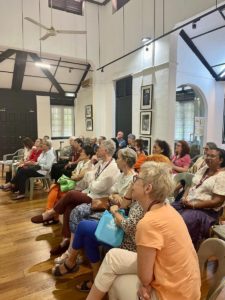The Grand Gibbon – From Kedah to Paris in the 18th Century
A presentation by Teckwyn Lim at Badan Warisan Malaysia on 7 February 2024


Teckwyn Lim is the Managing Director of Resource Stewardship Consultants Sdn Bhd (a company he co-founded in 2004). He is also a part-time lecturer at the University of Nottingham Malaysia. Teckwyn Lim holds a Ph.D. in wildlife ecology.
In his talk, Teckwyn Lim explored interspecies relations, focusing on the endangered gibbon. He shared haunting calls he recorded in Taman Negara, showcasing their unique songs and family life. No tails mark gibbons as apes, not monkeys. They live in small family groups and sing to each other every morning. The natural range of gibbons is throughout SE Asia up to North Myanmar.
Historically, gibbons reached France through trade routes in the 18th Century. 1766 Comte de Buffon mentions an actual individual animal: “This monkey, which I saw alive”…” of gentle and tractable disposition” but “very averse to cold.”
1754 Joseph-Francois Dupleix, Governor-General of French India, returned from Pondicherry with a live gibbon. This exotic gift for King Louis XV was entrusted to Madame de Pompadour, the king’s mistress and head of the royal menagerie. However, it did not survive the winter.
The species boundary is in SE Asia, so how did individual specimens reach India?
Teckwyn Lim explained that the Port of Kedah was already a place of considerable trade before the establishment of Penang as a Straits Settlement, and the British East India Company might have transported gibbons to India. A letter by the Sultan of Kedah mentions the transportation of elephants to India, so trade and shipment of individual animals from Kedah to India already existed.
Where does the word “gibbon” come from?
British linguists Skeat and Bladgen wrote a dictionary of the Orang Asli language. The word for monkey in the Orang Asli language is kabo or kebon, which is closely related to gibbon.
The gibbon is an endangered species today. Orang Asli hunt gibbons for meat and keep the young as pets. However, a worse issue is the loss of habitat through deforestation and the construction of highways. Lim highlighted the proximity of gibbon habitat to Kuala Lumpur, urging awareness. A key challenge in wildlife conservation lies in balancing human interaction with the protection of animal welfare and ecological stability.
Written by Martina Ziesse
